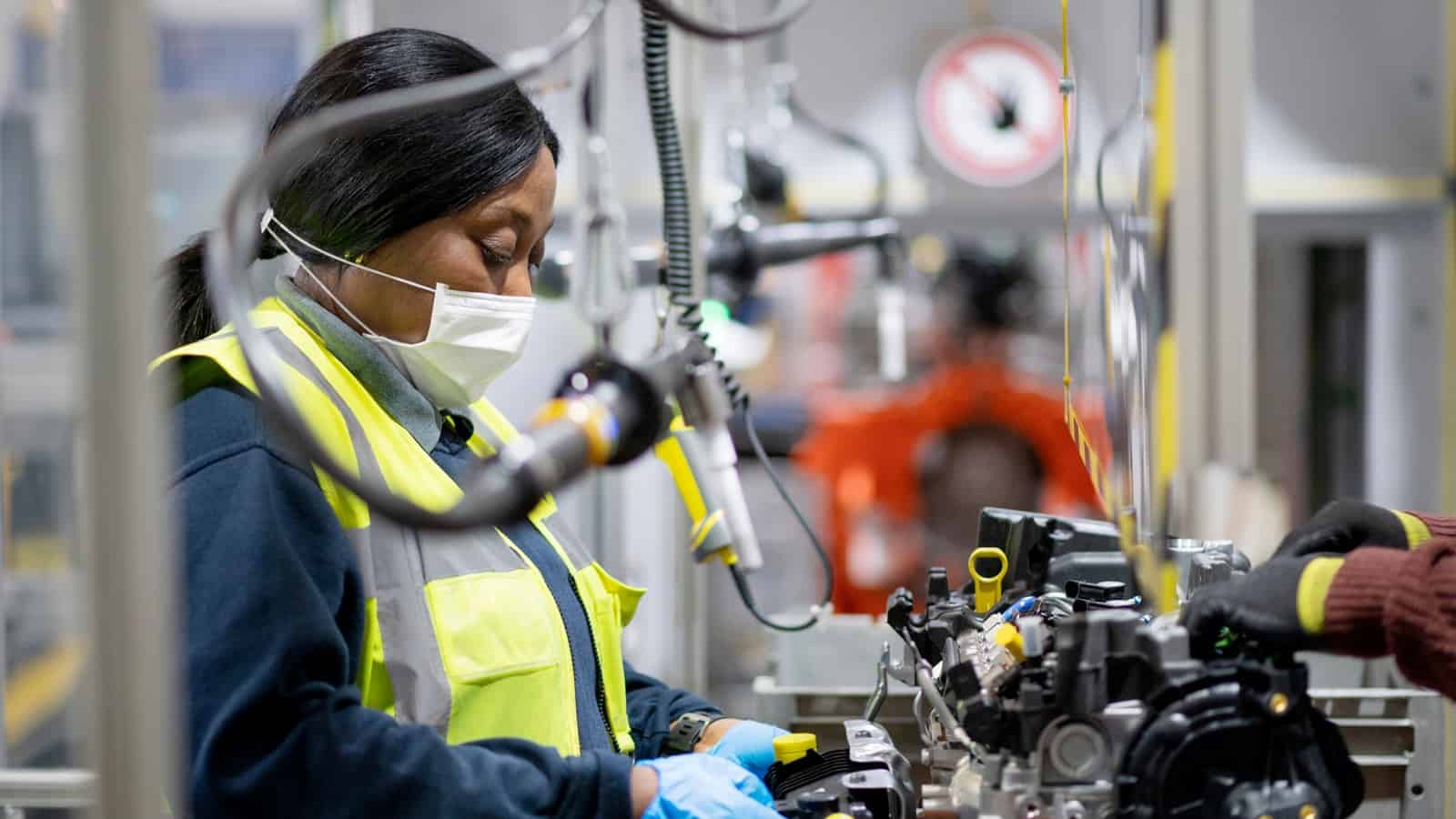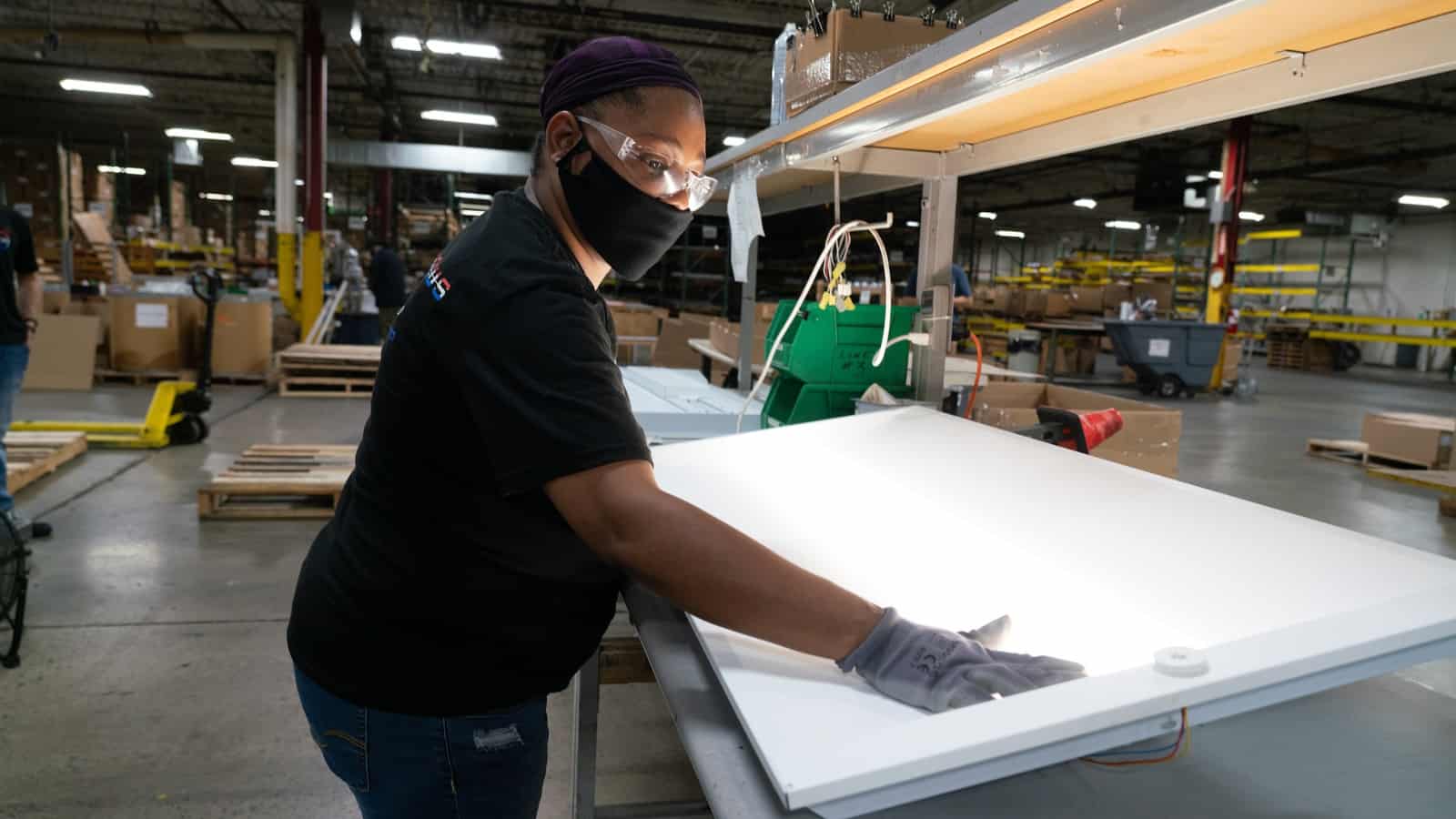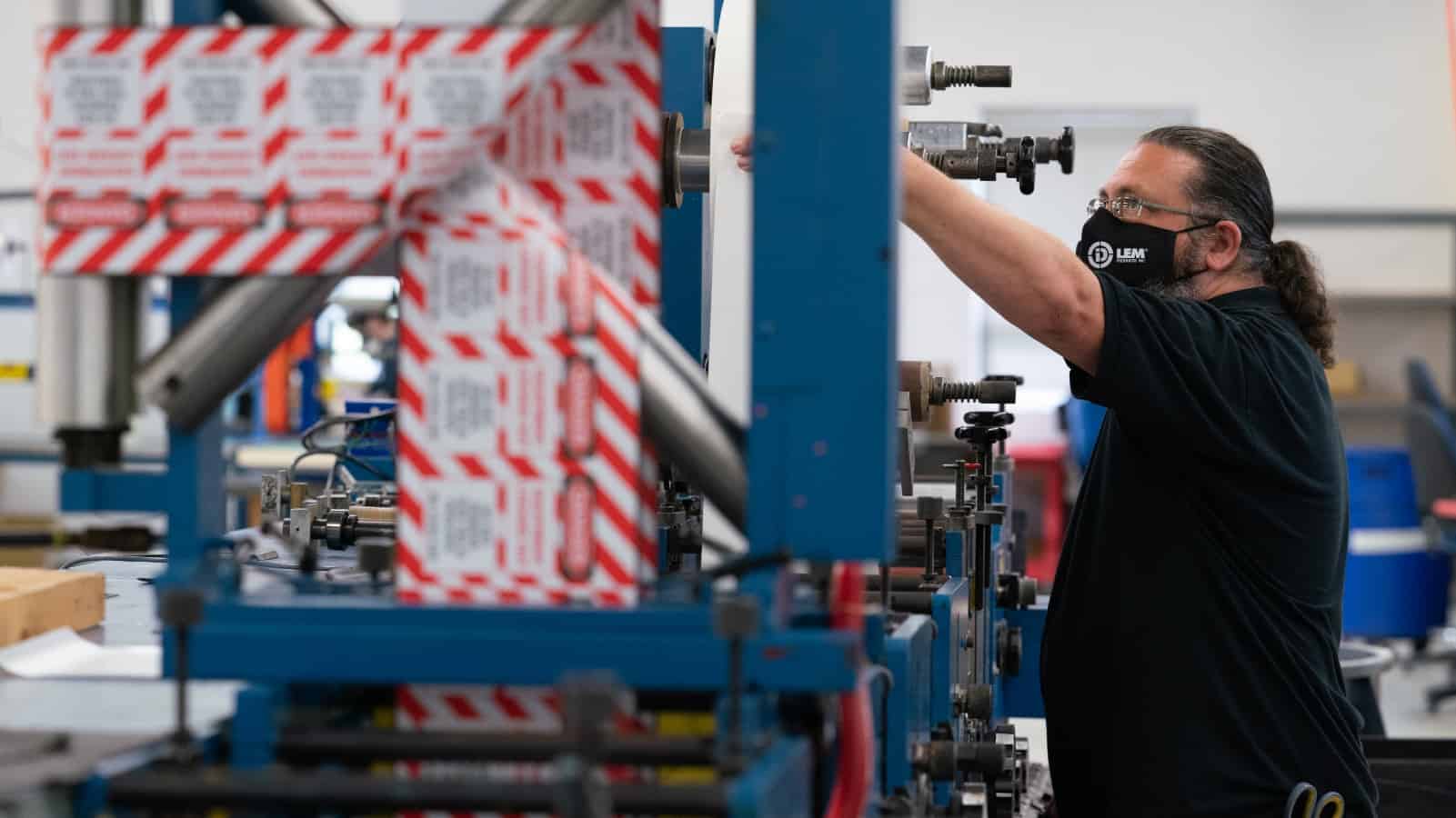The Future of Supply Chains

How are supply chains holding up under the stresses of COVID-19? How are companies preparing their supply chains for the future? As manufacturing endures a difficult year, these are key questions for all of us.
Fortunately, the new 2020 Digital Supply Chain Survey—a research initiative from Grant Thornton, the Manufacturing Leadership Council and the NAM—is here to tell us what we need to know.
The good news: While COVID-19 has caused widespread disruption in economic activity—and three-quarters of survey respondents reported some level of supply chain disruption—60% of respondents say that the disruption was only “minor.”
Still, according to the report, “around half had to rapidly reforecast demand, almost a third had to reduce production and two in five began to identify new suppliers as their existing global networks tried to cope with the initial disruption.”
The growth areas: The survey also identified a few areas where companies need to invest or make further progress:
- There’s room for growth in identifying supply chain risks (only 23% of companies called themselves “very capable” of doing so) and in accelerating digital maturity (just 17% of companies say their supply chains are fully integrated).
- More than half of companies—approximately 53%—say they are already beginning or considering redesigns of their entire supply chain processes.
Transformational tech: Companies are increasingly focused on making use of new technologies like artificial intelligence, machine learning systems and advanced analytics that would allow them to respond better to challenges—from shifts in markets to disasters like COVID-19.
The bottom line: “While transformational initiatives were already underway in many manufacturing supply chains before the COVID crisis, the lessons learned so far this year have clearly given those plans a new sense of urgency and a clearer focus for the years ahead.”
Sign up to get the executive summary and the forthcoming full report here. You can also register for a Dec. 8 webinar about the report, featuring Grant Thornton and the MLC, here.
How Manufacturers Can Prepare for Hurricanes

In any other year, a hurricane might be the worst catastrophe facing a manufacturer. And though all bets are off in 2020, hurricanes are still a major hazard. So how can leaders protect their operations and help their employees stay safe?
The National Association of Manufacturers’ Emergency Response Committee hosted a webinar recently to answer these important questions. It featured speakers from SBP, which works on the ground to support preparedness and resiliency; Kirby Corporation, a tank barge operator based in Texas; and Good360, a leader in philanthropy and purposeful giving. Here is some of their advice.
For workers: SBP Community Engagement Manager Amanda Gallina laid out important steps that individuals can take—and that companies can promote to their employees. These include:
- Collecting hazard and emergency information from local and national sources like news and weather apps, NOAA Weather Radio and the Red Cross Emergency app.
- Making a household emergency plan, which should include stockpiling supplies, establishing communication methods and emergency contact numbers, and creating an evacuation and sheltering plan.
- Identifying and protecting important documents by storing them in a fire- and water-proof box, while giving extra copies to a trusted attorney or friend. You can also use secure online cloud storage as another backup.
- Getting the right insurance by identifying any gaps in coverage and asking your agent the right questions.
- Protecting your property by taking a home inventory of your possessions using tools like myHOME, UPHelp Home Inventory and Sortly. You can also make proactive improvements to your home, such as flood protections and green infrastructure, using tools like the FEMA Property Protection Toolkit or dontgoof.org.
For businesses: Kirby Corporation Vice President of Public and Government Affairs Matt Woodruff shared what his company learned while mobilizing for Hurricane Sally in New Orleans. Here are his recommendations for other companies:
- Make sure new employees understand the hurricane plan well ahead of hurricane season.
- Create a checklist of duties for that must be performed, starting with the first day of hurricane season.
- Set up remote work sites for affected areas and employees.
- Provide support to the families of employees who live in affected areas to ensure their safety.
Woodruff also provided recommendations specific to his industry, including:
- Create vessel and facility inspection and response teams that can be repurposed to support affected families after a hurricane or other disaster.
“A lot of what you heard about preparing for your home is also what you do to prepared for your company,” said Woodruff. “You need to have a plan. That plan needs to be written, communicated, understood and exercised. And you need to be prepared to implement that plan early.”
Helping others: There are also plenty of ways for manufacturers to support people and companies after a disaster. Good360 Vice President of Disaster Recovery and Philanthropy Jim Alvey discussed how his organization partners with socially responsible companies, sourcing much-needed goods and distributing them through a network of diverse nonprofits.
“The goal for Good360 with the NAM members is to make it easy to donate products,” said Alvey. “And I’m talking about year-round—not just in a knee-jerk reaction to disasters. . . . If you have product in your warehouses taking up space, or you’re paying for disposal, Good360 can turn it into products that can help the community.”
The current mission? Getting large quantities (15,000 -20,000) of cleaning products—including buckets, cleaning supplies, cleaning tools and garbage bags—to aid the Hurricanes Laura and Delta recovery efforts in Louisiana. You can contact at Alvey at [email protected] to help.
Watch a recording of the webinar here. To contact the NAM’s emergency response committee or be put on its mailing list, email [email protected]
How Ford Made Its Factories Talk

The term “Symbiotic Simulation” might sound like a science fiction plot point, but in fact, it’s an incredibly useful framework that makes manufacturing processes more efficient by connecting digital tools with real-world facilities. Working with key partners, the Powertrain Manufacturing Engineering group at Ford Motor Company conceptualized and delivered this software solution. And this month, at the Manufacturing Leadership Council’s 2020 ML Awards, the MLC recognized the company’s work in developing it.
What it is: Symbiotic Simulation—or SymSim—is an evolution of discrete event simulation, which is when experts experiment on a computer model representing a facility in order to find improvement opportunities. Usually, that involves manually downloading data, reformatting it and pushing the data into a model ready for optimization.
SymSim shortens that process by making a direct connection to the data that is produced by facilities, pulling data out automatically to help the company understand what’s happening and how its goals can be accomplished more efficiently.
Why it matters: First, connecting the digital model more closely to the physical facility improves the quality of the simulation, which leads to better decisions and results. The second benefit is time. Traditionally, downloading the data, cleaning and processing it would take a week—but the SymSim process can do it almost instantaneously.
The long road: The idea was hatched in 2015, in a Ph.D. project by a member of the company’s PTME group. Once the Ph.D. project ended, the PTME group decided to build it out further, then added a few collaborators: software partner Lanner Group, as well as the University of East London and a team at sustainable manufacturing consultancy HSSMI.
The benefits: In general, the project has helped to improve efficiency and deliver savings by reducing overtime and eliminating costly delays. While Ford just launched the proof of concept in 2019, the project has already saved more than 1,000 hours of engineering time and around $2.7 million. In one Ford plant that was launching a brand-new engine assembly line, the company ran a daily meeting to show—in just 15 minutes—where the bottlenecks had been the day before.
The last word: “Sometimes it’s necessary to revolutionize,” said Ford Simulation & Process Optimization Leader Michael Higgins. “With these technologies, you can get stuck with making incremental changes. Sometimes you need to step back and ask how you can improve processes and leverage technological improvements on a grand scale. That’s exactly what we did.”
Along with many other leaders in manufacturing, Higgins will be one of the speakers at Rethink, the Manufacturing Leadership Council’s virtual summit on navigating disruption and seizing opportunities in the digital era. The summit will take place on October 27 to 29, 2020, and you can register here.
Lilly Is Helping People with Diabetes During the Pandemic—and Beyond

Many people who lost their jobs in the COVID-19 pandemic face a terrifying prospect: that they may not be able to pay for their lifesaving medications. Pharmaceutical manufacturer Eli Lilly and Company recognized that people with diabetes would be worried about affording insulin, so it stepped in to help all those in need—whether or not they have insurance.
The big idea: In April, the company introduced the Lilly Insulin Value Program $35 copay card to help people struggling financially—and while Lilly introduced it as a COVID-19 relief initiative, the company quickly decided to make it an ongoing program. In addition, starting January 2021, people enrolled in participating Medicare Part D plans will be able to access their Lilly insulin for no more than $35 per monthly prescription as part of the Senior Savings Model.
As a result, everyone—whether they have commercial insurance, Medicare Part D or no insurance at all—can opt in to receive their Lilly insulin for $35 per monthly prescription. For those who received the copay card in 2020, they simply need to re-enroll in the program in January 2021. For seniors, it’s important they enroll in a participating Medicare Part D plan during open enrollment (Oct. 15 – Dec. 7, 2020) to ensure they are eligible for this benefit.
A long record of affordability measures: Lilly has always been committed to making sure people get the insulin they need. In 2018, it unveiled the Lilly Diabetes Solution Center—a call center open Monday through Friday from 8:00 a.m. to 8:00 p.m. ET, with live operators fielding questions about insulin affordability and finding solutions for people who don’t know where to turn. The company has been able to drop pharmacy prices for some insulin users and has donated 100,000 insulin KwikPens® to nonprofits. And it is committed to solving even the largest challenges.
“If someone calls and says they’re desperate for insulin and they’re almost out, we’ll find a way to provide them with insulin,” said Lilly Diabetes Communications Senior Advisor Greg Kueterman. “We don’t want people rationing insulin. It’s not good for them, it’s not good for their health, and it’s not good for society.”
A new campaign: To get the message out about Lilly’s new initiative, the company is kicking off a program called “Insulin Affordability: Learn. Act. Share.”—encouraging people to learn about Lilly’s insulin affordability solutions, take action if they need the help and share information with friends and relatives.
The last word: “We want people to know that there’s now a solution out there for everybody,” said Kueterman. “No one needs to pay more than $35 per monthly prescription for their Lilly insulin if they take the right actions.”
You can learn more at insulinaffordability.com or by calling the Lilly Diabetes Solution Center at (1-833) 808-1234.
Why America Is a Great Location for Manufacturers

Manufacturing is a key driver of the American economy—but how does manufacturing in the United States stack up against the rest of the world?
Recently, The Manufacturing Institute and KPMG—a professional services firms providing innovative business solutions and audit, tax, and advisory services—released a new assessment of the cost of doing business in the manufacturing sector for the United States and 16 other major manufacturing exporting nations around the globe.
High costs, but high value: The study found that primary costs (compensation, property, utilities, taxes and interest rates) in the U.S. are on average 16% higher than in the other markets—yet the U.S. ranks fairly high on the list overall at #5.
- Another number bears that out: over the past decade, foreign direct investment in U.S. manufacturing has jumped from $569.3 billion in 2006 to a record $1,785.7 billion in 2019.
The benefits of tax reform: Tax reform made the U.S. a more desirable location for manufacturers, the study found. It compared how the U.S. would have ranked with its pre-reform corporate tax rate of 40% (the combined federal and state tax rate) instead of the post-reform corporate rate of 27%. With the old rate, the U.S. would have ranked only 11th.
The benefits of skilled workers: A major U.S. advantage is its supply of high-skilled workers. According to the study, the U.S. ranks at the top of the list for real value added per employee, along with Ireland and Switzerland. As manufacturing has become increasingly advanced, the need for sophisticated employees keeps growing.
While it’s true that American manufacturing requires more skilled workers, as The Manufacturing Institute has previously shown, the existing workforce is still a big draw due to its productivity.
The bottom line: The United States is an attractive location for manufacturers, despite relatively high costs, because of high worker productivity and the overall business environment.
The last word: “We need to continue to push the envelope of technological innovation and workforce development and recruitment in the manufacturing sector,” said Chad Moutray, chief economist for the National Association of Manufacturers and director of the Center for Manufacturing Research at The Manufacturing Institute. “These efforts will serve to strengthen the sector overall, but also help to maintain the nation’s global competitiveness.”
Manufacturing Leadership Awards Celebrate Innovative Manufacturers

Last night, the 2020 Manufacturing Leadership Awards Gala recognized some of the most innovative manufacturers in the country, at a virtual event hosted by the NAM’s Manufacturing Leadership Council. The MLC is a global business leadership network dedicated to preparing manufacturers for the opportunities and challenges posed by digitization, automation and technical advancement.
The winners: Presented to individuals and companies in 12 categories, including Sustainability Leadership and Artificial Intelligence and Analytics Leadership, the awards honor world-class manufacturing achievements. You can find the full list of honorees here.
The word from the MLC: “Creativity. Innovation. Excellence. Enlightened leadership. These are the qualities that drive the people of manufacturing to create a better future,” said MLC Co-Founder and Executive Director David Brousell in his opening remarks. “In doing so, they help themselves, their companies and our collective industry improve the quality of life for everyone. . . . All across this country, innovation in manufacturing is on the march.”
Manufacturer of the Year: The MLC honored two manufacturers with Manufacturer of the Year awards: agricultural chemical and seed company Corteva Agriscience, and Humtown Products, which was honored for its work to popularize 3D printing in sand cores. You can check out our profile of Humtown here.
Manufacturing Leader of the Year: This award went to Gerald Johnson, executive vice president, global manufacturing at GM, for his leadership in GM’s pivot to ventilator production in a partnership with Ventec Life Systems, code named Project V.
High Achiever Award Winners: The judges also presented high achiever awards to one winner in each category. Here’s the list:
- Lockheed Martin Corporation in the Artificial Intelligence and Advanced Analytics Leadership category for F-35 Augmented Reality Shop Floor Mobility
- Merck & Co., Inc., in the Collaborative Innovation Leadership category for Digital Fingerprinting
- Humtown Products in the Engineering and Production Technology Leadership category for Commercialization of 3D Printing in the Metal Casting Industry
- IBM in the Enterprise Integration Technology Leadership category for Migrating Supply Chain Quality Workload to Cloud
- Cooley Group in the Industrial Internet of Things Leadership category for Transforming Legacy Machinery into Smart Tech
- Hologic Inc. in the Operational Excellence category for Building a Culture of Operational Excellence
- Starkey Hearing Technologies in the Supply Chain Leadership category for Supply Chain Management Transformation
- The Boeing Company in the Sustainability Leadership category for Diverting Waste to Landfill While Upcycling Excess Airplane Carbon Fiber
- Nexteer Automotive in the Talent Management category for the Manufacturing Engineering Global Talent Management and Training Program
Manufacturers Lead by Example on COVID-19 Safety

This morning, the leadership of the NAM Board of Directors—Trane Technologies Chairman and CEO and NAM Board Chair Mike Lamach, Dow Chairman and CEO and NAM Board Vice Chair Jim Fitterling, BTE Technologies President and NAM Small and Medium Manufacturers Chair Chuck Wetherington and Protolabs President and CEO and NAM SMM Vice Chair Vicki Holt—released a joint statement to reinforce the industry’s critical role in the fight against COVID-19. The statement reaffirmed manufacturers’ commitment to science and to what’s necessary to plow ahead.
- United in the fight: “As manufacturers for America’s goods and essential products, we have a strong message for our team members and the country. All Americans must do everything in our power to keep our workers, our communities and our fellow citizens safe from COVID-19.”
- Leading by example: “Our industry will continue manufacturing personal protective equipment, medical supplies and therapeutics, racing to develop a safe and effective vaccine and keeping consumer goods and the food supply plentiful. We have been able to do this throughout the pandemic and keep our workers safe because we follow the science.”
- Concluding words: “We all must follow best practices and look out for each other so we can keep the country open, supply the world and defeat this invisible enemy.”
Read the full statement here.
NAM Board Leadership: Manufacturers Will Continue to Lead by Example
Washington, D.C. – The Board leadership of the National Association of Manufacturers is issuing a call to all Americans to observe COVID-19 safety protocols so manufacturers can continue to work to rebuild the economy. Trane Technologies Chairman and CEO and NAM Board Chair Mike Lamach, Dow Chairman and CEO and NAM Board Vice Chair Jim Fitterling, BTE Technologies President and NAM Small and Medium Manufacturers Chair Chuck Wetherington and Protolabs President and CEO and SMM Vice Chair Vicki Holt released the following joint statement:
“As manufacturers for America’s goods and essential products, we have a strong message for our team members and the country. All Americans must do everything in our power to keep our workers, our communities and our fellow citizens safe from COVID-19.
“Our industry will continue manufacturing personal protective equipment, medical supplies and therapeutics, racing to develop a safe and effective vaccine and keeping consumer goods and the food supply plentiful. We have been able to do this throughout the pandemic and keep our workers safe because we follow the science.
“We will continue to set the right example by practicing the guidance outlined by the CDC and other medical experts. That’s why we encourage all Americans to wear a mask, social distance, avoid large gatherings, use contact tracing and quarantine for 14 days if there is direct exposure to the virus, especially when one is tested positive. We are on the front lines of rebuilding our economy, but we cannot do so until we defeat COVID-19, and we cannot defeat COVID-19 if we fail to protect each other.
“COVID-19 has already taken more than 210,000 American lives, and each week that number grows by the thousands. The economic toll has resulted in millions of jobs lost—some permanently. Among those who survive, many will endure lifelong disabilities. It doesn’t have to be this way. We know the science, and we have the tools. We all must follow best practices and look out for each other so we can keep the country open, supply the world and defeat this invisible enemy.”
-NAM-
The National Association of Manufacturers is the largest manufacturing association in the United States, representing small and large manufacturers in every industrial sector and in all 50 states. Manufacturing employs more than 12.1 million men and women, contributes $2.36 trillion to the U.S. economy annually and has the largest economic multiplier of any major sector and accounts for 63% of private-sector research and development. The NAM is the powerful voice of the manufacturing community and the leading advocate for a policy agenda that helps manufacturers compete in the global economy and create jobs across the United States. For more information about the NAM or to follow us on Twitter and Facebook, please visit www.nam.org.
CDC Acknowledges Airborne Transmission

The CDC updated its guidance on transmission of COVID-19 to clarify that it spreads through airborne transmission, CNBC reports.
What it all means: While the CDC says COVID-19 is still much more likely to be transmitted through respiratory droplets when someone sneezes, coughs, talks or breathes, it’s also possible for smaller particles of the virus to stay in the air for several minutes—or even hours—and spread between people who are more than six feet apart.
Ventilation is key: The new guidance heightens the importance of proper ventilation in fighting the spread of the virus. The CDC clarifies that most airborne transmission happens in poorly ventilated indoor spaces, especially during activities like exercise or singing that might cause people to breathe more heavily.
The recommendation: The CDC is still recommending the same behaviors as before, which include:
- Wear a mask that covers your nose and mouth;
- Social distance by staying at least six feet away from others;
- Wash your hands frequently;
- Clean high-touch surfaces often; and
- Stay home if you feel unwell.
A word from the NAM: “For months, manufacturers have gone above and beyond the recommendations of health officials to protect the health and safety of our nation’s essential workers,” said NAM Director of Labor and Employment Policy Drew Schneider. “Manufacturers are using existing ventilation systems and outdoor air to reduce airborne spread of COVID-19 by increasing air circulation, allowing outdoor air into facilities and using air purifiers. NAM members are still following CDC guidance for social distancing, face coverings and proper hygiene and will continue to retool their facilities in accordance with the recommendations of health experts.”
Global COVID-19 Toll Reaches 1 Million

As concerns grow about another wave of COVID-19 infections this fall and winter, the world has passed a grim milestone: 1 million deaths from COVID-19, The Wall Street Journal (subscription) reports. Here’s the latest on the resurgence of COVID-19 both in the United States and abroad.
- Europe prepares for another wave, sans lockdowns: Cities across Europe are fighting a surge in COVID-19 infections by strengthening social distancing rules—but they aren’t returning to full lockdowns, like those that were put in place this spring, The Wall Street Journal (subscription) reports.
- The numbers for the U.S.: More than 20 U.S. states report COVID-19 spikes over the past week. Meanwhile, an analysis of Johns Hopkins University data found that only 11 states saw cases decline more than 10% in that same time period, The Hill explains. The remaining states reported level infection rates.
- Trouble in the Midwest: Positive COVID-19 test rates have risen above 25% in some Midwest states, an analysis by Reuters found. North Dakota’s positive test rate is averaging 30%, while South Dakota’s has reached 26%. “The World Health Organization considers rates above 5% concerning because it suggests there are more cases in the community that have not yet been uncovered,” Reuters explains.
NAM in action: As the nation prepares for a potential uptick in COVID-19 cases, it becomes even more important to encourage greater adherence to safety practices that limit community spread. A few weeks ago, the NAM launched the “Creators Respond Commitment” to help manufacturing companies encourage wider outside-of-work compliance with safety practices. You can access the email templates to share this campaign with your team members at this link.
